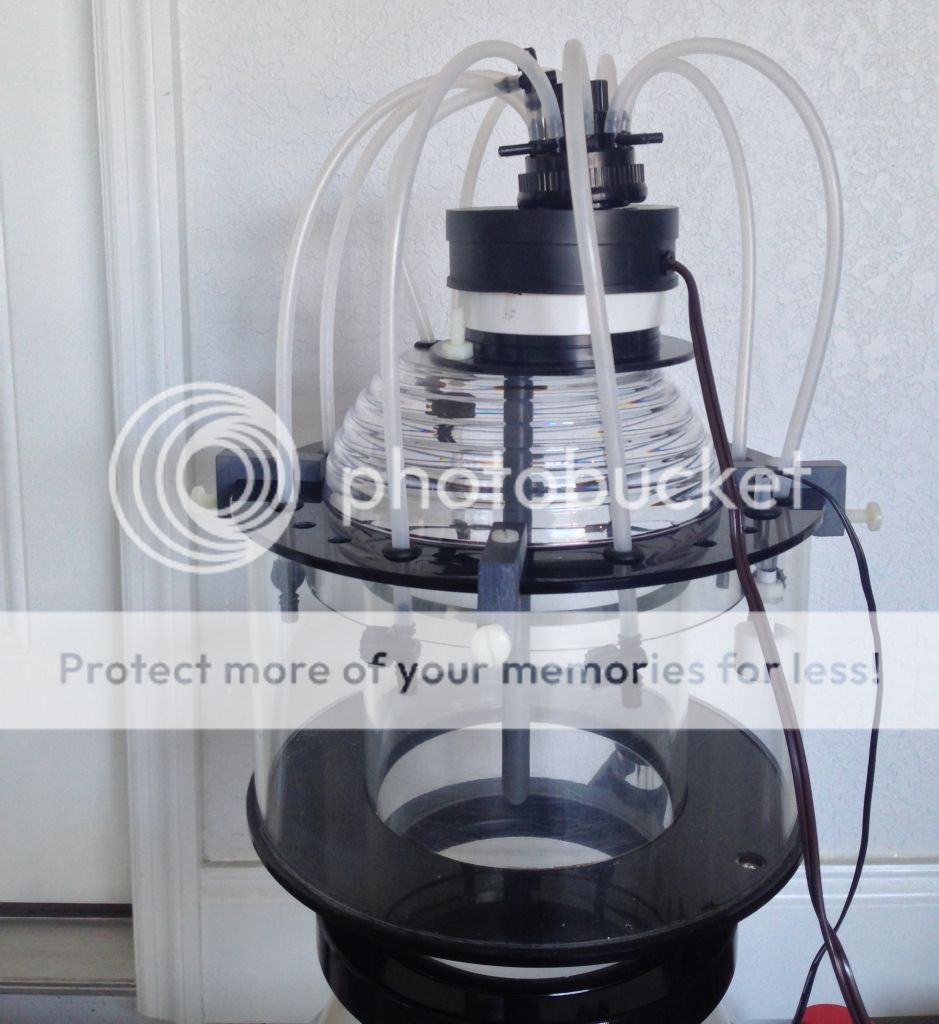Ok, so as I looked at the design of nearly every skimmer, I see many flaws. Of course these are probably more "cost" associated than anything else.
The one major flaw I see is the design of the flat lid. Logic tells us that the reason why the skimmer lid is always loaded with gunk is because that's where the bubbles are popping. How many of these bubbles are actually popping and falling back into the neck? I don't know and I'm not going to watch a slow frame video and try to count bubble bursts.
Nevertheless, I did decide to add a dome to my lid. My logic behind this is that I'll increase skimmate production and efficency because A) The foam height will be greater and more easily fall over the edge and into the cup and B) When the bubble does pop on the domed lid it will travel along the slope into the cup rather than into the neck. During my research on this I found that every single person who ran their skimmer without the lid saw an increase in skimmate production.
The next mod I executed was the standard neck cleaner with a squeegee. There's really nothing special here as other have done it and many companies sell neck cleaners for about triple what it would cost you to do it yourself. Of course the benefit to a neck cleaner is that there is a certain point when the neck is so dirty that skimmate production slows down and it must be cleaned. With the neck cleaner you will always have peak performance from a clean neck perspective.
Finally, the last mod I added was a complete wash down system. I thought about what I'd have to do to keep my skimmer running great and how could I automate it and the bottom line is you have to clean the neck and wash the cup. So with this mod my skimmer cup and domed lid will get a blast wash down from the micro jet sprinklers I installed. This will be fed by a pump in a separate RODI container. I'll also add a solenoid to the drain to open in conjunction with the cleaning process.
Of course all of this will be automated daily with my Apex including the use of the float switch inside the skimmer cup.
There are still a few more adjustments I need to finish. I'll order the squeegee from Avast and I need to figure out a better way to secure the float switch. For some reason I'm having trouble locating hollow plastic threaded pipe. I may change the orientation of the manifold too. I'm not sure how I want to secure it as I'm still working on acquiring equipment for my latest build. It will most definitely have a union for easy removal. I just installed it for the photographs.


The one major flaw I see is the design of the flat lid. Logic tells us that the reason why the skimmer lid is always loaded with gunk is because that's where the bubbles are popping. How many of these bubbles are actually popping and falling back into the neck? I don't know and I'm not going to watch a slow frame video and try to count bubble bursts.
Nevertheless, I did decide to add a dome to my lid. My logic behind this is that I'll increase skimmate production and efficency because A) The foam height will be greater and more easily fall over the edge and into the cup and B) When the bubble does pop on the domed lid it will travel along the slope into the cup rather than into the neck. During my research on this I found that every single person who ran their skimmer without the lid saw an increase in skimmate production.
The next mod I executed was the standard neck cleaner with a squeegee. There's really nothing special here as other have done it and many companies sell neck cleaners for about triple what it would cost you to do it yourself. Of course the benefit to a neck cleaner is that there is a certain point when the neck is so dirty that skimmate production slows down and it must be cleaned. With the neck cleaner you will always have peak performance from a clean neck perspective.
Finally, the last mod I added was a complete wash down system. I thought about what I'd have to do to keep my skimmer running great and how could I automate it and the bottom line is you have to clean the neck and wash the cup. So with this mod my skimmer cup and domed lid will get a blast wash down from the micro jet sprinklers I installed. This will be fed by a pump in a separate RODI container. I'll also add a solenoid to the drain to open in conjunction with the cleaning process.
Of course all of this will be automated daily with my Apex including the use of the float switch inside the skimmer cup.
There are still a few more adjustments I need to finish. I'll order the squeegee from Avast and I need to figure out a better way to secure the float switch. For some reason I'm having trouble locating hollow plastic threaded pipe. I may change the orientation of the manifold too. I'm not sure how I want to secure it as I'm still working on acquiring equipment for my latest build. It will most definitely have a union for easy removal. I just installed it for the photographs.










